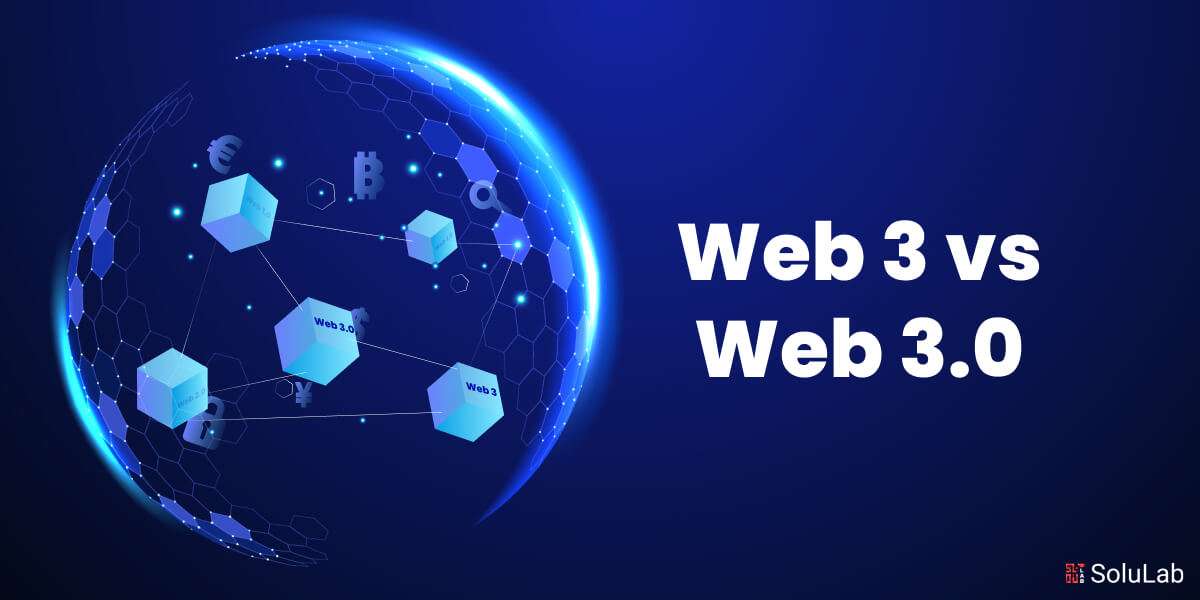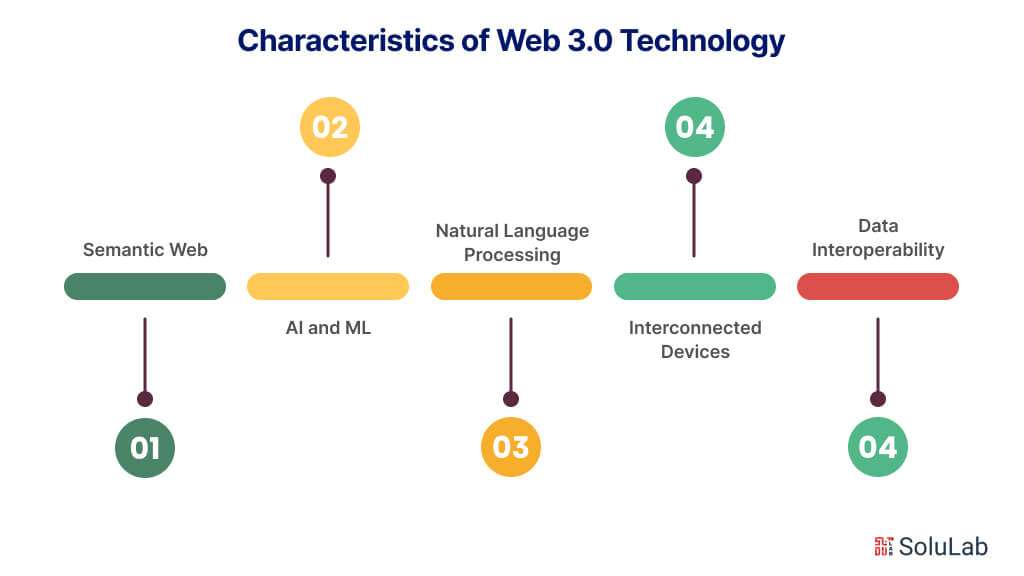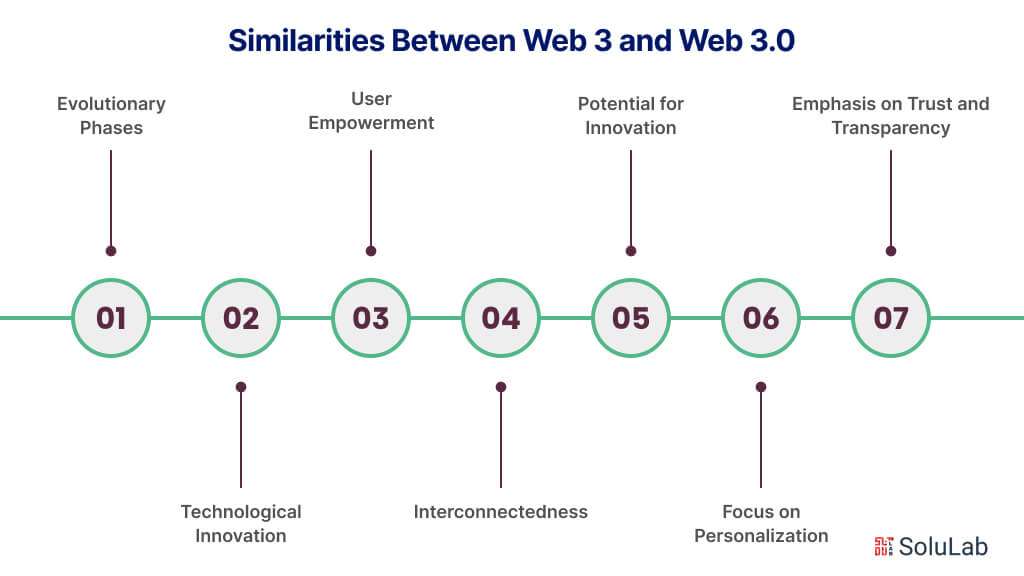
With every new iteration of the internet, there are new opportunities, difficulties, and paradigms to be faced. The internet has continuously changed how we connect, communicate, and do business, starting with the static pages of Web 1.0 and continuing with the dynamic and networked platforms of Web 2.0. The ideas of Web 3.0 are already emerging as symbols of innovation and change as we approach the dawn of a new age.
However, what precisely are these phrases and how are they different? In this blog, we will look at the specifics of Web 3 vs Web 3.0, exploring their underlying ideas, useful uses, and possible future implications for the Internet.
What Is Web 3?
Co-founder of Ethereum Gavin Wood came up with the term “Web 3” in 2014 to describe his idea of a better, democratic, and decentralized internet. It’s a response to the way things are now, where a small number of tech giants heavily influence internet infrastructure and usage.
Web 3, in contrast to the existing online reality, presents a peer-to-peer approach that eliminates any monopolistic effect of a single party by relying more on users’ efforts to the network and infrastructure.
Blockchain technology, the main technology behind cryptocurrencies, is the foundation of Web 3. Decentralization, made possible by blockchain, guarantees that users may help build a network without being hindered by a powerful entity.
Trust is another important idea. At the moment, we believe that companies are using our data with good motives. This is frequently untrue. Web 3 wants to transform the internet into a “trustless” environment where businesses are replaced by blockchain-based algorithms. Therefore, we will be able to trust the technology itself instead of a firm.
In general, Web 3 development may open the door to an online ecosystem that is more transparent and has a more equitable power structure.
Read Also: Top Web3 Development Companies
Key Tenets of Web 3
Central to the ethos of Web 3 are several foundational principles:
- Decentralization: Web 3 seeks to dismantle centralized control, redistributing power and authority to individual users and communities. By removing intermediaries and gatekeepers, it fosters a more equitable and resilient internet.
- Trustlessness: Through the use of cryptographic protocols and consensus mechanisms, Web 3 eliminates the need for trust between parties, ensuring the integrity and security of transactions and interactions.
- Transparency: Web 3 promotes radical transparency, enabling users to trace the flow of information and value across the network. By making data and processes openly accessible, it fosters accountability and prevents censorship.
- User Empowerment: In the Web 3 paradigm, users have greater autonomy and ownership over their digital identities, assets, and interactions. Through self-sovereign identity solutions and decentralized governance models, individuals can reclaim control over their online presence.
Practical Applications of Web 3 Technology
Web 3 technologies manifest in a myriad of applications and platforms, including:
- Blockchain: The underlying technology powering the Web 3 platform, blockchain serves as a decentralized ledger for recording and verifying transactions. It facilitates peer-to-peer (P2P) interactions without the need for intermediaries.
- Smart Contracts: Self-executing contracts encoded on the blockchain, smart contracts automate the execution of predefined terms and conditions, enabling secure and transparent transactions.
- Decentralized Finance (DeFi): DeFi platforms leverage blockchain technology to offer financial services such as lending, borrowing, and trading in a decentralized manner, circumventing traditional financial intermediaries.
- Non-Fungible Tokens (NFTs): Unique digital assets tokenized on the blockchain, NFTs represent ownership or proof of authenticity for digital art, collectibles, and other digital content.
- Decentralized Autonomous Organizations (DAOs): DAOs are self-governing entities governed by smart contracts and operated by their members. They enable collective decision-making and resource allocation without centralized control.
What is Web 3.0
Web 3.0, often referred to as the Semantic Web or the Intelligent Web, represents the next phase in the evolution of the World Wide Web. While there isn’t a universally agreed-upon definition, Web 3.0 generally refers to a vision of the internet where information is not only interconnected but also understood by computers in a meaningful way. In other words, it’s a more intelligent and intuitive web experience.
Characteristics of Web 3.0 Technology

Key characteristics and features of Web 3.0 include:
- Semantic Web: In Web 3.0, data is not just linked but also structured in a way that computers can understand and interpret it. This involves adding metadata, annotations, and other semantic information to web content, allowing machines to infer context and relationships between different pieces of information.
- Artificial Intelligence (AI) and Machine Learning: Web 3.0 leverages AI and machine learning algorithms to process and analyze vast amounts of data, enabling more personalized and intelligent user experiences. These technologies power virtual assistants, chatbots, recommendation systems, and other applications that can understand user preferences and behaviors.
- Natural Language Processing (NLP): Natural Language Processing (NLP) allows computers to understand and generate human language, enabling more natural and intuitive interactions between users and machines. This includes features such as voice search, sentiment analysis, and language translation, which enhance the accessibility and usability of web applications.
- Interconnected Devices (Internet of Things – IoT): Web 3.0 extends beyond traditional web browsers to include a wide range of interconnected devices, from smartphones and smartwatches to smart home appliances and industrial sensors. This interconnectedness enables seamless data exchange and communication between devices, leading to more integrated and automated workflows.
- Data Interoperability: Web 3.0 promotes data interoperability by using standardized formats, protocols, and APIs that enable different systems and platforms to exchange and integrate data more easily. This facilitates the creation of more comprehensive and interconnected information networks, enabling users to access and analyze data from multiple sources.
Overall, Web 3.0 represents a shift towards a more intelligent, interconnected, and context-aware web experience, where information is not only accessible but also understandable and actionable by machines. While the full realization of Web 3.0 is still evolving, its potential to revolutionize how we access, interact with, and derive value from the internet is increasingly apparent.
Read Also: How to Build And Launch Web3 App?
A Comparative Analysis Between Web 2 vs Web 3.0
| Web 2 | Web 3.0 |
| Signified the transition from static websites to dynamic web applications, enabling user-generated content, social networking, and interactive platforms. | Represents the next evolutionary stage, integrating advanced technologies such as AI, IoT, and semantic web to create more intelligent, personalized, and interconnected web experiences. |
| Focuses on enhancing user engagement, interactivity, and community-building through social media, blogging, and collaborative platforms. | Emphasizes the integration of AI, IoT, and semantic web technologies to enable more intelligent, context-aware, and automated web experiences. |
| Offers greater interactivity, personalization, and social connectivity, enabling users to engage with content and communities in more meaningful ways. | Aims to deliver more intelligent, personalized, and intuitive user experiences by leveraging AI, NLP, and IoT technologies to understand user preferences and automate tasks seamlessly. |
| Data ownership and privacy are often centralized in the hands of platform owners, raising concerns about data misuse, surveillance, and privacy breaches. | Prioritizes user sovereignty and data ownership, enabling individuals to reclaim control over their data, identities, and digital interactions through decentralized technologies such as blockchain and self-sovereign identity solutions. |
| Relies on advertising-based revenue models, where platforms monetize user attention and data through targeted advertising and sponsored content. | Introduces new economic models such as decentralized finance (DeFi) and tokenized ecosystems, where value is distributed more equitably among participants through blockchain-based incentives, smart contracts, and decentralized governance mechanisms. |
Similarities Between Web 3 and Web 3.0

There are two concepts that stand out as beacons of innovation and progress: Web 3 and Web 3.0. While distinct in their technological focus and implementation strategies, these paradigms share common ground in their overarching goals and principles. Both Web 3 and Web 3.0 represent evolutionary phases in the development of the Internet, building upon the foundations of Web 1.0 and Web 2.0 to usher in a new era of connectivity, intelligence, and user empowerment. Moreover, they share a commitment to fostering trust, transparency, and inclusivity in the digital realm, recognizing the importance of empowering users and creating more democratic and equitable online environments.
Here are some similarities between Web 3 and Web 3.0:
- Evolutionary Phases: Both Web 3 and Web 3.0 represent significant advancements in the development of the internet, following the progression from Web 1.0 and Web 2.0. They signify shifts towards more advanced, interconnected, and user-centric internet paradigms.
- Technological Innovation: Both concepts incorporate cutting-edge technologies to enhance the functionality and capabilities of the Internet. While Web 3 focuses on decentralized technologies like blockchain, Web 3.0 integrates AI, IoT, and semantic web technologies to create more intelligent and intuitive web experiences.
- User Empowerment: Both Web 3 and Web 3.0 emphasize empowering users by providing greater control over their data, identities, and interactions. They seek to shift power away from centralized entities and toward individuals, fostering a more democratic and inclusive Internet ecosystem.
- Interconnectedness: Both concepts promote the idea of an interconnected web where data, devices, and applications can seamlessly communicate and collaborate. Whether through blockchain networks in Web 3 or IoT devices in Web 3.0, the goal is to create a more integrated and interoperable digital environment.
- Potential for Innovation: Both Web 3 and Web 3.0 hold the potential to drive innovation and transformative change across various industries and sectors. By leveraging emerging technologies and reimagining the architecture of the internet, they offer opportunities for new business models, applications, and user experiences.
- Focus on Personalization: Both paradigms prioritize personalized experiences tailored to individual preferences and behaviors. Whether through AI-driven recommendations in Web 3 or semantic web technologies in Web 3.0, the aim is to deliver more relevant and engaging content to users.
- Emphasis on Trust and Transparency: Both Web 3 and Web 3.0 recognize the importance of trust and transparency in the digital realm. Whether through decentralized governance mechanisms in Web 3 or semantic data standards in Web 3.0, efforts are made to enhance trustworthiness and accountability in online interactions.
Differences Between Web 3 and Web 3.0
Here are the key differences between Web 3 and Web 3.0:
| Web 3 | Web 3.0 |
| Web 3 primarily revolves around blockchain technology and decentralized protocols, aiming to create a more transparent, secure, and user-centric internet. | Web 3.0 integrates advanced technologies such as artificial intelligence (AI), the Internet of Things (IoT), and semantic web technologies to create more intelligent, interconnected, and context-aware web experiences. |
| Web 3 emphasizes decentralization, trustlessness, and user sovereignty, seeking to empower individuals and communities by redistributing control and ownership over data and digital interactions. | Web 3.0 focuses on enhancing the intelligence and interoperability of the internet, leveraging AI, IoT, and semantic web technologies to create more personalized, intuitive, and interconnected web experiences. |
| Web 3 applications primarily revolve around decentralized finance (DeFi), non-fungible tokens (NFTs), decentralized autonomous organizations (DAOs), and other blockchain-based solutions aimed at democratizing access to financial services, digital assets, and governance. | Web 3.0 applications span a wide range of domains, including AI-driven virtual assistants, smart home automation, semantic search engines, personalized recommendations, and IoT ecosystems, aiming to enrich user experiences and automate processes across various sectors. |
| Web 3 offers users greater control over their data, identities, and interactions, promoting transparency, privacy, and autonomy in online interactions. However, user interfaces and experiences may vary in complexity due to the decentralized nature of many Web 3 applications. | Web 3.0 focuses on delivering more intelligent, personalized, and intuitive user experiences, leveraging AI, NLP, and IoT to understand user preferences, anticipate needs, and automate tasks seamlessly. This results in more user-friendly and context-aware web applications. |
| Interoperability between different blockchain networks and decentralized applications (dApps) is a key challenge in Web 3, often requiring bridging solutions and interoperability protocols to facilitate seamless data exchange and communication. | Web 3.0 promotes interoperability between diverse data sources, devices, and platforms through standardized formats, protocols, and APIs, enabling seamless integration and data exchange across the web. This facilitates the creation of more comprehensive and interconnected information networks. |
Implications of Web 3 and Web 3.0
The introduction of Web 3 and Web 3.0 signals a fundamental change in how we use the internet and the wider digital world. These innovative frameworks have a plethora of ramifications across several domains, impacting stakeholders and reshaping digital interactions, economics, and social structures in the future.
-
Empowerment of Users:
Web 3 and Web 3.0 prioritize user sovereignty, enabling individuals to reclaim control over their data, identities, and digital interactions. This empowerment fosters trust, transparency, and autonomy in online environments, empowering users to make informed decisions and assert their rights.
-
Disruption of Traditional Industries:
The decentralized nature of Web 3 challenges traditional business models and intermediaries across various sectors. Industries such as finance, healthcare, supply chain management, and entertainment face disruption as decentralized technologies enable peer-to-peer transactions, automated processes, and disintermediation.
-
Democratization of Finance and Governance:
Web 3 facilitates the democratization of finance through decentralized finance (DeFi) platforms, enabling broader access to financial services, investment opportunities, and wealth creation. Similarly, decentralized autonomous organizations (DAOs) empower communities to govern and manage resources collectively, bypassing centralized authorities.
-
Redefinition of Digital Ownership and Value Exchange:
Web 3 introduces new paradigms of digital ownership and value exchange through concepts like non-fungible tokens (NFTs) and decentralized marketplaces. Users can tokenize and trade digital assets, including art, collectibles, intellectual property, and virtual goods, creating new avenues for monetization and cultural expression.
-
Transformation of Digital Identity and Privacy:
Web 3 and Web 3.0 offer solutions for enhancing digital identity management and privacy through self-sovereign identity (SSI) and zero-knowledge proofs. Users have greater control over their personal data and can authenticate and verify identities without relying on centralized entities, enhancing security and privacy in online interactions.
-
Evolution of Digital Workflows and Collaboration:
Decentralized technologies facilitate new modes of collaboration and value creation, enabling distributed teams, freelancers, and contributors to collaborate seamlessly across borders and organizational boundaries. Smart contracts and decentralized applications (dApps) automate workflows, streamline processes, and ensure fair and transparent compensation.
-
Amplification of Social Impact and Civic Engagement:
Web 3 and Web 3.0 empower individuals and communities to address social challenges and advance civic causes through decentralized governance mechanisms and crowdfunding platforms. DAOs enable collective decision-making and resource allocation, fostering grassroots movements and community-driven initiatives.
Concluding Remarks
In conclusion, managing the quickly changing digital world requires a grasp of the differences between Web 3 and Web 3.0. Web 3.0 denotes the next stage of the internet’s development, marked by modern innovations like AI, IoT, and blockchain. Web 3 refers to the decentralized internet idea that promotes user control and privacy. Using these technologies to provide a more efficient, safe, and networked online experience is part of embracing Web 3.0. Both individuals and companies must be informed as we move toward a decentralized future and adjust to the fundamental shift that Web 3.0 brings about.
SoluLab is a light of knowledge and creativity for anyone looking to make use of Web 3 possibilities. SoluLab, a top Web 3 development company, provides complete solutions designed to satisfy the particular requirements of companies entering the decentralized market. You can confidently handle the challenges of blockchain integration, smart contract creation, and decentralized application deployment with the help of SoluLab’s team of skilled Web 3 developers. Hire Web 3 developers from SoluLab today to advance your digital transformation in Web 3 development.
FAQs
1. What is the primary difference between Web 3 and Web 3.0?
Web 3 refers to the concept of a decentralized internet, emphasizing user control and privacy, while Web 3.0 represents the next phase of internet evolution, integrating advanced technologies like blockchain, AI, and IoT for a more interconnected digital experience.
2. How does Web 3.0 impact data privacy and security compared to Web 3?
Web 3.0 incorporates decentralized technologies like blockchain to enhance data privacy and security significantly. Unlike Web 3, where user data is often centralized and vulnerable to breaches, Web 3.0 offers decentralized data storage and encryption, reducing the risk of unauthorized access and manipulation.
3. What are some key features of Web 3.0 that distinguish it from its predecessor?
Web 3.0 introduces several groundbreaking features, including smart contracts, decentralized applications (DApps), and enhanced interoperability between different platforms. These features enable autonomous transactions, self-executing contracts, and seamless communication across the decentralized web.
4. How can businesses leverage the potential of Web 3.0 for innovation and growth?
Businesses can harness Web 3.0 technologies to streamline operations, improve transparency, and foster trust among customers. By integrating blockchain, AI, and IoT into their systems, companies can create innovative solutions, optimize supply chains, and explore new revenue streams in the decentralized economy.
5. How does SoluLab contribute to the adoption of Web 3.0 for businesses?
SoluLab serves as a leading Web3 development company, offering expertise in blockchain integration, smart contract development, and decentralized application deployment. By partnering with SoluLab, businesses can access a team of skilled Web3 developers who specialize in leveraging innovative technologies to drive digital transformation and growth.






